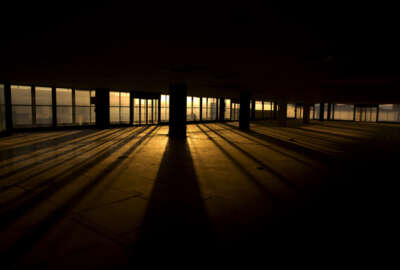
Carter rebukes House plan to add funds, troops to Defense budget
Defense Secretary Ash Carter called the House proposal "deeply troubling," saying it would pay for additional troops and pay boosts at the expense of long-term...
Defense Secretary Ash Carter said Wednesday that he could not support a legislative strategy that would move $18 billion into the Pentagon’s base budget for 2017, saying the proposal was “deeply troubling and flawed.”
Carter was referring to the House Armed Services Committee’s version of the annual Defense authorization bill, which that panel’s members began marking up Wednesday morning. It would maintain tens of thousands more soldiers and Marines than DoD’s current budget plan allows, purchase more military hardware than the Pentagon requested and fund additional training and maintenance for weapons platforms and military bases.
“It buys one year of force structure without the money to sustain it and keep it ready, effectively creating hollow force structure and working against our efforts to restore readiness,” Carter said. “And it does not address the much bigger strategic risk DoD faces of $100 billion in looming automatic cuts.”
In order to stay within the parameters of the two-year federal budget deal lawmakers reached at the end of last year, the House plan, authored by Armed Services Committee Chairman Mac Thornberry (R-Texas), would move $18 billion of the funds DoD requested for its overseas contingency operations (OCO) accounts into its base budget.
That reallocation would technically keep the House proposal within the $610 billion allowed for Defense in 2017, but would completely drain the OCO accounts by April — just six months into the fiscal year — leaving the next president and Congress with the decision to either add tens of billions more dollars to Defense, or effectively end military operations in the Middle East and other overseas activities like the European Reassurance Initiative.
“It is gambling with warfighting money at a time of war, proposing to cut off our troops’ funding in places like Afghanistan, Iraq and Syria in the middle of the year,” Carter said. “It is a step in the direction of unraveling the Bipartisan Budget Act, which provided the critical stability DoD needs now and desires for the future. And it is another road to nowhere with uncertain chances of ever becoming law and a high probability of leading to more gridlock and another continuing resolution — exactly the kind of distraction that’s undercut stable planning and efficient use of taxpayer dollars for years now.”
Thornberry sees things quite differently, arguing that the base budget plus-up is imperative if the military is to begin bouncing back from the degrading readiness that its generals and admirals have been warning about since 2011, when the Budget Control Act capped agency budgets and created budget turmoil in every year since.
“This approach is certainly not preferable,” he told the Defense Writers Group last week. “But the highest priority here is to make sure that whatever we’re asking these men and women to do, they’re fully prepared and supported to do it. And if you can’t fully support them, they shouldn’t go do it. Because you are risking their lives.”
Among many other provisions, Thornberry’s proposal would halt the Army’s plan to draw down its active duty force to 450,000 soldiers and hold it steady at its current size of about 480,000. Military pay would be increased by 2.1 percent next year rather than the 1.6 percent the Pentagon requested.
Navy and Air Force depot maintenance would grow by $530 million and $160 million, respectively; the bill would also pay for 90 percent of base maintenance needs compared to the 75 percent level in the Pentagon’s own budget proposal, helping to address a severe backlog in facility upkeep.
Some of $18 billion would also go to fund acquisition programs, including 11 more F-35 fighters than DoD included in its budget and thousands of rockets and missiles to replenish munitions stocks that have been depleted in the air campaign against the Islamic State militants.
“Everything we’ve put in there has been on the military services’ unfunded requirements list, and by and large, they’re things that DoD said they intended to buy as of last year,” Thornberry said. “This is not stuff we’re inventing. I think that the best thing for us to do now is to ensure that for whatever operational deployments our men and women are sent on by this president or the next, they will be prepared, and they will be supported.”
Rep. Adam Smith (D-Wash.), the top Democrat on the Armed Services committee, said he remained undecided about whether to support the chairman’s funding approach, but said it was “incredibly problematic.”
“First, it cuts funding for Overseas Contingency Operations so that we will run out of money for them halfway through the year while we still have troops in Iraq and Afghanistan, an approach that puts our forces on the road to a fiscal cliff,” he said. “Second, by prohibiting the military from adopting numerous measures that would allow it to save money — most notably a BRAC and reductions in force posture — we put the military in a terrible position. This strategy is essentially based on hope that more money will magically appear to solve this problem, and hope is not a strategy.”
Indeed, in and of itself, the annual NDAA can’t and doesn’t address the Budget Control Act provisions that first resulted in sequestration in 2013 and which continue to place strict limits on federal spending through the early 2020s. In every year since the BCA was enacted, DoD and the rest of government has operated under continuing resolutions for at least part of each year while Congress and the White House worked out one-off deals to fund the government, usually in ways that only delayed the spending reductions the legislative and executive branches first agreed to in 2011.
Unless the BCA is repealed or altered yet again, the “security” portion of the federal budget would be reduced by several billion dollars each year even compared against the Pentagon’s own request.
“DoD’s greatest strategic risk is losing the stability we got from the budget deal this year and having uncertainty and sequester return in future years,” Carter said. “That is why going forward, the biggest budget priority for us strategically is Congress averting the return of sequestration to prevent automatic cuts so we can maintain stability and sustain all these critical investments over time.”
Copyright © 2025 Federal News Network. All rights reserved. This website is not intended for users located within the European Economic Area.
Jared Serbu is deputy editor of Federal News Network and reports on the Defense Department’s contracting, legislative, workforce and IT issues.
Follow @jserbuWFED





